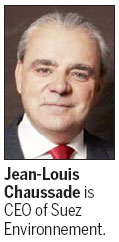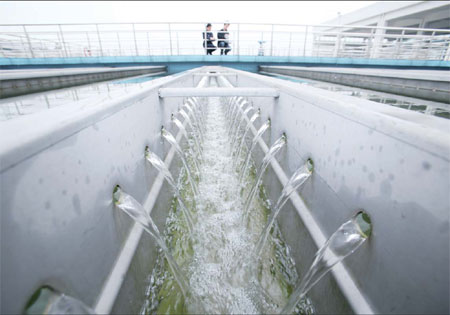China's wellspring of demand
Updated: 2013-01-04 09:44
By Meng Jing (China Daily)
|
|||||||||||
|
Suez Environnement foresees more wastewater treatment plants, including sludge treatment, in China. Provided to China Daily |

The quest for water and waste solutions means big business for french Utility company
'Making the planet sustainable is the best job on earth," says the French utility company Suez Environnement on its website's homepage.
It is also one of the best businesses for the multinational water and waste solution provider - especially when it comes to China.
Despite China's slowing economy, Paris-based Suez Environnement plans to invest more in the country, where environmental protection and sustainable development are becoming the top priorities for the central and local governments.
"We've seen an increasing awareness in sustainable development in China. The slowdown shouldn't impact companies in the field of the environment, where China is still investing a huge amount of money," says Jean-Louis Chaussade, CEO of the group, which posted global revenue of 14.8 billion euros ($19.8 billion) in 2011.
He says it will continue heavy investment in the water and waste sector worldwide by about 1.2 to 1.3 billion euros this year.
"The eurozone crisis is very complex. The situation in the US is not much better. But if you take the other way around, the less we invest in Europe, the more we can invest in China," Chaussade told China Daily in November, after he signed a memorandum of understanding to open up a new research and development center in Chongqing municipality in Southwest China.
The company has been expanding rapidly in China, setting up two to three new joint ventures every year. It now has 27.
"We are not only raising our investment in China by opening up new joint ventures, but also by expanding our existing companies," Chaussade says.
In Chongqing, the 50-50 partnership between the company's subsidiary, Sino French Water, and Chongqing Water Group increased its registered capital from $50 million in 2002 to $265 million last year.
Suez Environnement reported global revenue of 11.1 billion euros for the first three quarters of 2012, showing 1.3 percent overall growth year-on-year, but 10 percent growth in the Asia-Pacific region, where the Chinese market is the driving force.
In 2011 the company had income of more than 1 billion euros from its activities in China.
Europe still represents two thirds of Suez Environnement's market.
"Five years ago, the international market was around 20 percent of our 12 billion-euro revenue. Now it has grown to 30 percent of our business, and our business has grown to roughly 15 billion euros a year, which means our international activity has almost doubled over the past five years," says Chaussade.
He has also seen strong business growth in the US and Australia but says China is the market with the most potential, especially when dealing with its scarcest resource, water.
"It is all about the conflict between China's large population and its acute water shortage," he says, adding that 80 percent of his company's business in China is water-related.
Though China accounts for about 20 percent of the global population, its freshwater resources are just 7 percent. The per capita water resources quota in China is 2,100 cubic meters, or 28 percent of the global average.
Increasing water demand driven by the country's rapid urbanization, growing middle class and higher sanitation requirements greatly adds to the pressure on supplies.
For Chaussade, the most notable factor in his company's China business is that water demand at a plant in Chongqing surged 25 percent in a year.
"That is something that has never happened in Europe."
He uses China's South-to-North Water Diversion Project, the largest of its kind in the world, to illustrate China's vastly increasing demand.
"It is not because the Chinese government likes big, big projects, but because the underground water in Beijing is going down, down, down."
"So especially in China, you need to combine the best water management, which means how can we provide the right amount of water to the population with minimum leakage and reasonable consumption? How can we reuse water as much as we can, to preserve water as much as we can?"
At Suez Environnement's new research and development center in Chongqing, 20 researchers are set to provide solutions to optimizing the operation of network systems, reducing leakage, and finding more durable materials, among other tasks to help China tackle its water crisis.
The Chinese government has recognized its water problem and moved it much higher on its agenda.In January 2012, the State Council issued its first work paper, calling it the "most strict water resources management system", and setting out specific objectives for water consumption, efficiency and water pollution.
At the same time, the Ministry of Water Resources also announced an ambitious plan to invest more than 140 billion yuan ($22.2 billion; 16.9 billion euros) on water conservancy projects this year, while the total investment on such projects between 2011 and 2015 is expected to be about 1.8 trillion yuan.
Chaussade says he has seen a clear shift of focus in China from purely economic development to sustainable development.
"Water is becoming the very core of sustainable development issues because it is a mix of population consumption, industrial requirements and agricultural needs."
China's rapidly expanding water sector, valued at $48 billion, is the third largest in the world, according to the research firm GWI Global Water, behind the United States at $110 billion and Japan at $59 billion. Analysts estimate that the industry value may triple to $150 billion over the next five years.
Suez Environnement is not the only company that has found water is the new gold in China, with State-owned enterprises, private and international companies all vying for a share.
Chaussade says there is increasing competition in the sector. "In 10 to 15 years there will be consolidation," he says. "I can see three to five Chinese companies emerging from that consolidation."
For its part, Suez Environnement has been expanding its business from the increasingly competitive conventional water supply and distribution to sewage and sludge treatment, and more high-tech industrial water treatment.
Charles Chaumin, Asia CEO of Suez Environnement, says water supply and distribution account for two-thirds of the company's water business in China.
"But we will see more wastewater treatment facilities, including sludge treatment both for municipalities and industrial parks," he predicts. "In five years our water and wastewater business will be 50-50 in China."
Chaussade says moving toward more technical water treatment is a natural process.
"Water is always an issue when a country is accelerating its development. They first need water as soon as the country starts development. Then they say they have pollution, so they need sewage treatment plants. When treating wastewater, comes the by-product sludge, so they have to treat sludge as well."
When Chaussade made his first trip to Australia in 2000, he says, all the authorities he met said Australia would never need seawater desalination projects.
"Now, there are big desalination projects in Melbourne, in Sydney and almost everywhere. We have no desalination project in China, but I'm pretty sure China will need that very soon."
mengjing@chinadaily.com.cn
(China Daily 01/04/2013 page21)
Today's Top News
Police continue manhunt for 2nd bombing suspect
H7N9 flu transmission studied
8% growth predicted for Q2
Nuke reactor gets foreign contract
First couple on Time's list of most influential
'Green' awareness levels drop in Beijing
Palace Museum spruces up
Trading channels 'need to broaden'
Hot Topics
Lunar probe , China growth forecasts, Emission rules get tougher, China seen through 'colored lens', International board,
Editor's Picks

|

|

|

|

|

|






